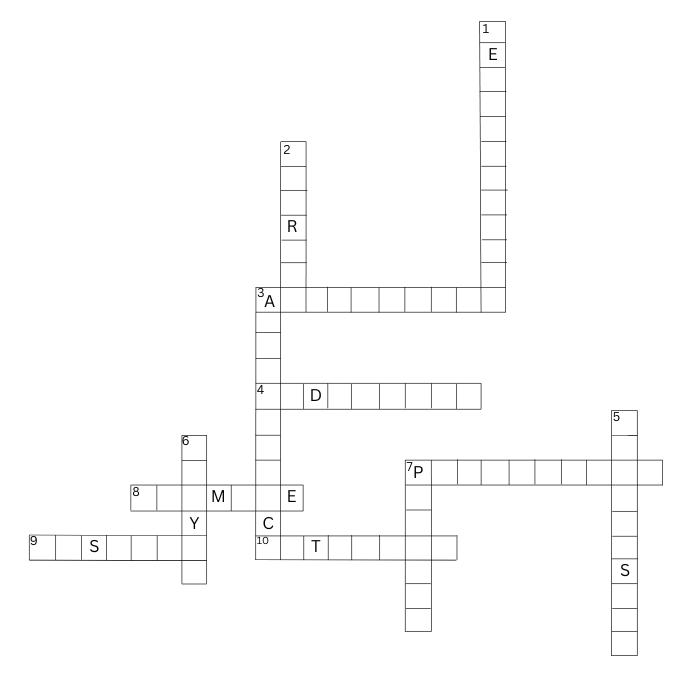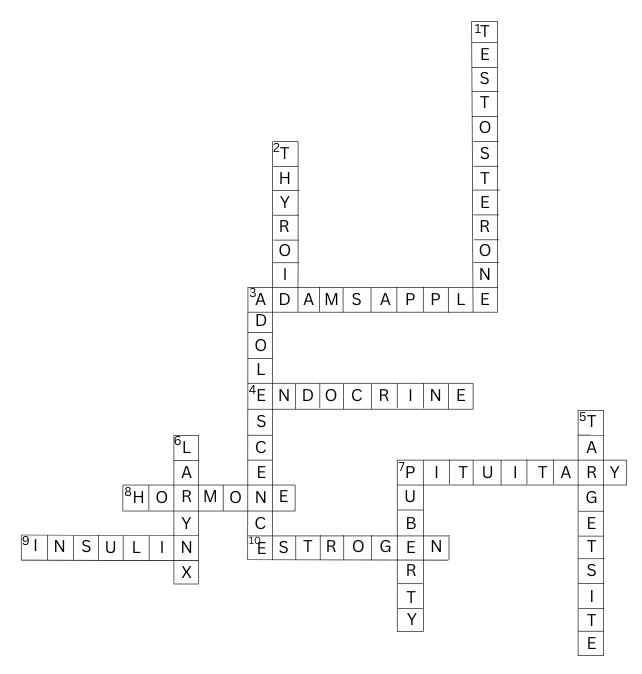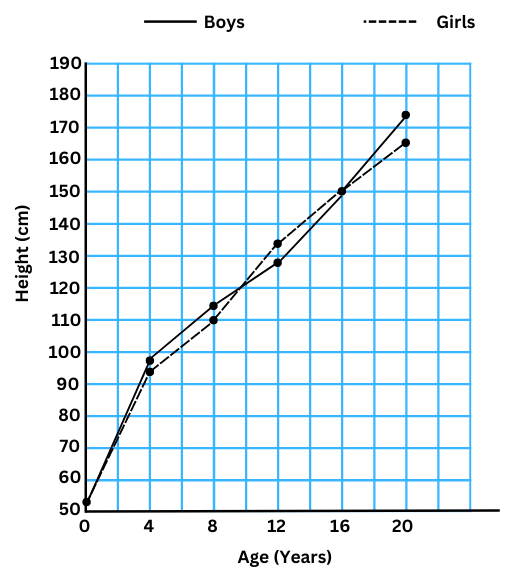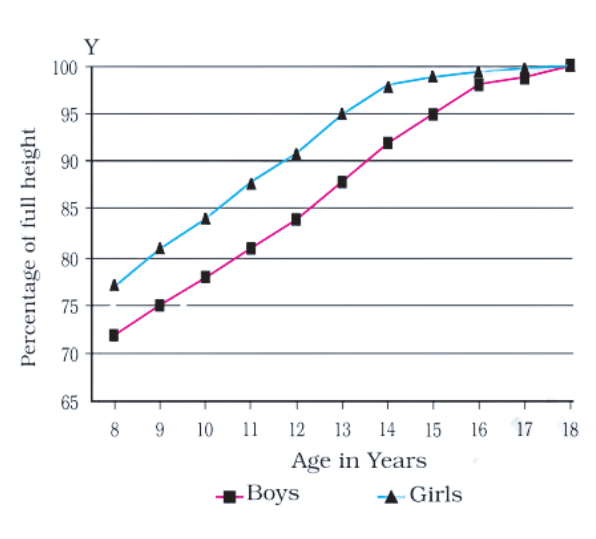Hello students! Find below the complete solutions package for Chapter 7 that you have been waiting for. All the exercise questions, extended learning activities, in-text questions and activities for this chapter have been thoroughly answered in this material. We recommend that you understand the concepts in this chapter in detail instead of just memorising them. Studying our solutions material in detail will clear your concepts and prepare you for your exams.
Solutions to Exercises (Page No 90) of NCERT Class 8 Science 7 Reaching the Age of Adolescence
1. What is the term used for chemical secretions of endocrine glands responsible for changes taking place in the body?
Answer:
The term used for chemical secretions of endocrine glands responsible for changes taking place in the body is hormones.
2. Define adolescence.
Answer:
Adolescence is the period of life, when the body undergoes changes, leading to reproductive maturity. Adolescence begins around the age of 11 and lasts upto 18 or 19 years of age.
3. What is menstruation? Explain.
Answer:
Menstruation is the bleeding which occurs during shedding of the unfertilised female egg along with the thickened lining of the uterus. It occurs once in every 28 to 30 days.
4. List changes in the body that take place at puberty.
Answer:
The changes that take place in the body at puberty are as follows:
- There is sudden increase in height for both boys and girls.
- Boys develop broader shoulders, wider chests and more prominent muscles then girls. In girls, the region below the waist becomes wider.
- Boys develop larger voice boxes which makes the voice hoarse.
- Increased activity of sweat and sebaceous glands gives young people acne and pimples.
- Boys and girls develop sex organs.
- In girls menstruation starts.
- Secondary sex characters develop like facial hair in boys and breasts in girls.
- Adolescents become more independent and intellectual development takes place.
- An adolescent may feel insecure while adjusting to changes in the body and mind.
5. Prepare a Table having two columns depicting the names of endocrine glands and hormones secreted by them.
Answer:
| Endocrine glands | Hormones |
| Testis | Testosterone |
| Ovary | Estrogen |
| Pancreas | Insulin |
| Adrenal | Adrenalin |
| Thyroid | Thyroxin |
| Pituitary Gland | Growth hormone |
6. What are sex hormones? Why are they named so? State their function.
Answer:
Sex hormones are chemical substances secreted by sex organs. The male sex hormone testosterone is secreted by the testes and the female sex hormone estrogen is secreted by the ovary. They are they named so because of their role in reproduction.
Functions of both sex hormones are stated below:
Testosterone: Testosterone causes development of secondary sex characters in males like facial hair, beards etc and also plays a role in reproduction.
Estrogen: Estrogen causes development of secondary sex characters in females such as breasts and mammary glands inside breasts. It also plays a role in reproduction.
7. Choose the correct option.
(a) Adolescents should be careful about what they eat, because
(i) proper diet develops their brains.
(ii) proper diet is needed for the rapid growth taking place in their body.
(iii) adolescents feel hungry all the time.
(iv) taste buds are well developed in teenagers.
Answer: Adolescents should be careful about what they eat, because (ii) proper diet is needed for the rapid growth taking place in their body.
(b) Reproductive age in women starts when their
(i) menstruation starts.
(ii) breasts start developing.
(iii) body weight increases.
(iv) height increases.
Answer: Reproductive age in women starts when their (i) menstruation starts.
(c) The right meal for adolescents consists of
(i) chips, noodles, coke.
(ii) chapati, dal, vegetables.
(iii) rice, noodles and burger.
(iv) vegetable cutlets, chips and lemon drink.
Answer: The right meal for adolescents consists of (ii) chapati, dal, vegetables. This is a balanced meal with the right amounts of proteins, carbohydrates, fats and vitamins in requisite proportions.
8. Write notes on—
(a) Adam’s apple.
(b) Secondary sexual characters.
(c) Sex determination in the unborn baby.
Answers:
(a) Adam’s apple.
The Adam’s apple is the protruding bulge of the throat in males. This bulge is due to the growing voice box or larynx in boy’s throats during puberty.
(b) Secondary sexual characters.
Secondary sexual characters are features that help distinguish the male from the female. Boys develop secondary sexual characters like chest hair. In both boys and girls, hair grows under the arms and in the region above the thighs or the pubic region.
(c) Sex determination in the unborn baby.
Sex determination in the unborn baby is due to the sex chromosome, either X or Y, of the male sperm that fertilizes the egg. When a sperm containing X chromosome fertilises the egg, result is a female child. If the sperm contributes a Y chromosome to the egg (ovum) at fertilisation, the result is a male child.
9. Word game:
Use the clues to work out the words.
Across
3. Protruding voice box in boys
4. Glands without ducts
7. Endocrine gland attached to brain
8. Secretion of endocrine glands
9. Pancreatic hormone
10. Female hormone
Down
1. Male hormone
2. Secretes thyroxine
3. Another term for teenage
5. Hormone reaches here through blood stream
6. Voice box
7. Term for changes at adolescence

Answer:

10. The table below shows the data on likely heights of boys and girls as they grow in age. Draw graphs showing height and age for both boys and girls on the same graph paper. What conclusions can be drawn from these graphs?
| Age (Years) | Height (cm) | |
| Boys | Girls | |
| 0 | 53 | 53 |
| 4 | 96 | 92 |
| 8 | 114 | 110 |
| 12 | 129 | 133 |
| 16 | 150 | 150 |
| 20 | 173 | 165 |
Answer:
On the graph paper we take:
On the y-axis: 10 cm = 1 unit
On the x-axis: 2 years = 1 unit
The graph is shown below:

Between the years 8 – 12 girls grow faster than boys. This is because girls reach puberty around this age, which is earlier than boys.
Between the years 12 – 16 boys grow faster than girls. This is because boys reach puberty around this age, which is later than girls.
Solutions to Extended Learning – Activities and Projects (Page No 92) of NCERT Class 8 Science Chapter 7 Reaching the Age of Adolescence
1. Find out from your elder relatives about their awareness of the legal status of early marriage. You yourself may get information on it from your teacher, parents, a doctor or the internet. Write a two-minute speech explaining why early marriage is not good for the couple.
Answer:
Solution to Extended Learning Problem 1
2. Collect newspaper cuttings and information in magazines about HIV/ AIDS. Write a one page article of 15 to 20 sentences on HIV/AIDS.
Answer:
Solution to Extended Learning Problem 2
3. In our country, according to 2011 census, there are 940 adolescent females for every 1000 males. Find out.
(a) the concerns of the community regarding this low ratio. Remember that the chance of having a boy or a girl is equal.
(b) what amniocentesis is and how useful this technique is. Why is its use for identification of sex of the unborn child banned in India?
Answer:
Solution to Extended Learning Problem 3
4. Put your ideas together and write a short note on the importance of knowing facts about reproduction.
Answer:
Solution to Extended Learning Problem 4
Solutions to In Text Questions of NCERT Class 8 Science Chapter 7 Reaching the Age of Adolescence
1. (Page 79) I wonder how long this period marked by changes in the body will last!
Answer:
This periodmarked by changes in the body called adolescence begins around the age of 11 and lasts upto 18 or 19 years of age. Therefore, it lasts for about 8 years on average.
2. (Page 79) It is a strange period of life when you are neither a child nor an adult. I wonder whether this period between childhood and adulthood had a special name!
Answer:
This period between childhood and adulthood has a special name called adolescence. Adolescence is when the body undergoes changes, leading to reproductive maturity. It begins around the age of 11 and lasts upto 18 or 19 years of age.
3. (Page 80) Paheli and Boojho realised that sudden increase in height and hairy line above the lips in boys were signs of adolescence. They wanted to know more about other changes at puberty.
Answer:
The other changes at puberty are increase in height, change in body shape, voice change, development of sex organs, mental, intellectual and emotional maturity and development of secondary sex characters like facial hair, breast etc.
4. (Page 84) Paheli says that the reproductive life of a woman lasts from menarche to menopause. Is she right?
Answer:
Yes, she is right. This is because reproductive maturity starts with the first menstrual flow called menarche and continues till menopause, which is around 45 to 50 years of age.
5. (Page 84) I heard my mother and my aunt talking about my cousin who is going to have a baby. They were discussing whether she would give birth to a boy or a girl. I wonder what makes the fertilised egg develop either into a boy or a girl!
Answer:
The sex chromosome, either X or Y, of the male sperm that fertilizes the egg determines whether the fertilised egg will develop into a boy or a girl. When a sperm containing X chromosome fertilises the egg, result is a female child. If the sperm contributes a Y chromosome to the egg (ovum) at fertilisation, the result is a male child.
6. (Page 86) Are there hormones in other animals also? Have they any role to play in reproduction?
Answer:
Yes there are hormones in other animals also. They have roles to play in reproductionsuch as in mating behaviours, ovulation, and pregnancy.
7. (Page 86) If people do not have enough iodine in their diet, will they get goitre caused by lack of thyroxine?
Answer:
If people do not have enough iodine in their diet, they will indeed get goitre caused by lack of thyroxine. The thyroid gland requires iodine to synthesize thyroxine. When there is iodine deficiency, the thyroid gland enlarges to trap more iodine, resulting in the swelling of the thyroid tissue known as goitre.
Solutions to All Activities of NCERT Class 8 Science Chapter 7 Reaching the Age of Adolescence
1. Complete Activity 7.1 (Page 80). The following chart gives the average rate of growth in height of boys and girls with age. The figures in columns 2 and 3, give the percentage of the height a person has reached at the age given in column 1. For example, by the age 11, a boy has reached 81% of his probable full height, while a girl has reached 88% of her full height. These figures are only representative and there may be individual variations. Use the Table for your friends and work out how tall they are likely to be. Find out who is likely to be the tallest and who might be the shortest in your class.
| Age in Years | % of full height | |
| Boys | Girls | |
| 8 | 72% | 77% |
| 9 | 75% | 81% |
| 10 | 78% | 84% |
| 11 | 81% | 88% |
| 12 | 84% | 91% |
| 13 | 88% | 95% |
| 14 | 92% | 98% |
| 15 | 95% | 99% |
| 16 | 98% | 99.5% |
| 17 | 99% | 100% |
| 18 | 100% | 100% |
Calculation for full height (cm) = (Present Height)/(% of full height at this age) × 100
Example:
A boy is 9 years old and 120 cm tall. At the end of the growth period he is likely to be = (120/75) × 100 cm = 160 cm tall
Answer:
2. Complete Activity 7.2 (Page 81). Use the data given in Activity 7.1 to draw a graph. Take age on the X-axis and per cent growth in height on the Y-axis. Highlight the point representing your age on the graph. Find out the percentage of height you have already reached. Calculate the height you might eventually reach. Tally your graph with the one given here (Fig. 7.1).

Answer:
3. Complete Activity 7.3 (Page 86). Collect information from magazines or from doctors and prepare a note on the importance of consuming iodised salt. You can also look for this information on the internet.
Answer:
4. Complete Activity 7.4 (Page 87). Make a group with your friends. Write down the items of food in your breakfast, lunch and dinner you had on the previous day. Identify the items responsible for proper growth. Also identified the junk food that you consumed the previous day.
Answer:
5. Complete Activity 7.5 (Page 87). Get ideas from the pictures given in Fig.7.6. Prepare charts or posters and paste them in the class so that you are aware of the diet for adolescents. You may use your creative ideas and present it like an advertisement. You may even organise a competition on this topic.
Answer:
6. Complete Activity 7.6 (Page 88). Collect data on the number of children in your class who exercise regularly and who do not exercise regularly. Did you notice any difference in their fitness and health? Prepare a report on the benefits of regular exercise.
Answer:
Extra Questions to Complement Solutions to NCERT Class 8 Science Chapter 7 Reaching the Age of Adolescence
Very Short Answer Type:
1. Name the period between childhood and adulthood.
Answer:
Adolescence.
2. What is the most important change that takes place during puberty?
Answer:
Boys and girls become capable of reproduction.
3. What is the voice box also known as?
Answer:
Larynx.
4. Which glands are called ductless glands?
Answer:
Endocrine glands.
5. Between the years 10 – 12, who shows more growth – boys or girls?
Answer:
Girls.
6. What are secretions from endocrine glands called?
Answer:
Hormones.
7. What is stoppage of menstrual cycle called?
Answer:
Menopause.
8. A sperm containing Y chromosome fertilises the egg. What will be the gender of the child?
Answer:
Boy.
9. Lack of secretion of which hormone cause diabetes?
Answer:
Insulin.
10. What is the main nutrient in pulses?
Answer:
Protein.
Multiple Choice Questions (MCQs):
1. The production of the male and female hormones is under the control of another hormone secreted from an endocrine gland called:
(a) Pituitary gland
(b) Sebaceous glands
(c) Ovary
(d) Testes
Answer: (a) Pituitary gland
2. How frequently is an ovum released by the ovaries?
(a) Once a week
(b) Once a month
(c) Once in 14 days
(d) Once in 20 days
Answer: (b) Once a month
3. Pregnancy occurs when
(a) The wall of the uterus thickens
(b) The egg gets fertilised
(c) Menarche occurs
(d) Before menopause
Answer: (b) The egg gets fertilised
4. Lack of secretion of which gland causes goitre?
(a) Pituitary gland
(b) Thyroid gland
(c) Adrenal gland
(d) Pancreas
Answer: (b) Thyroid gland
5. Which of the following is a balanced meal?
(a) Rice, daal, chappati, curd
(b) Roti, aloo sabji, dahi
(c) Rice, daal, chicken, saak
(d) Rice, daal, chicken, potato fries
Answer: (c) Rice, daal, chicken, saak
Short Answer Type:
1. Name glands which release their secretions through ducts.
Answer:
Sweat glands, oil glands and salivary glands release their secretions through ducts.
2. Why do young people get acne on their face?
Answer:
During puberty the sweat and sebaceous glands become hyperactive and release lot of secretions. These secretions block the skin pores and people get swellings called acne on their faces.
3. Why are endocrine glands called ductless glands?
Answer:
Endocrine glands are called ductless glands because they do not have ducts and release hormones directly into the bloodstream.
3. Name the endocrine glands which are involved in reproduction.
Answer:
The endocrine glands which are involved in reproduction are testes, ovary and pituitary glands.
4. Why are males capable of reproduction for a longer period than females?
Answer:
The capacity for maturation and production of gametes lasts for a much longer time in males than in females.
5. What is menstruation?
Answer:
If fertilisation by sperm does not occur, the released egg, and the thickened lining of the uterus along with its blood vessels are shed off. This causes bleeding in women which is called menstruation.
6. Name the female sex chromosomes and the male sex chromosomes.
Answer:
Females have two X chromosomes, males have one X chromosome and one Y chromosome.
7. Name two functions of adrenal glands.
Answer:
Adrenal glands secrete hormones which maintain the correct salt balance in the blood. Adrenal glands also produce the hormone adrenalin. It helps the body to adjust to stress when one is very angry, embarrassed or worried.
8. Water in which tadpoles grow must contain sufficient iodine. Explain.
Answer:
In frogs the growth cycle from larva to adult is controlled by the hormone thyroxine. Thyroxine production requires the presence of iodine in water. If iodine is not present in sufficient amounts, the tadpoles cannot become adults.
9. Why is mother’s milk considered a balanced food for infants?
Answer:
Mother’s milk contains all essential nutrients such as carbohydrates, proteins, fats, vitamins, and minerals. This composition is specifically tailored to meet the nutritional needs of infants during the early months of life.
10. What advice is given to adolescents regarding drug use?
Answer:
Theadvice is given to adolescents regarding drug use is that if anybody suggests that you will get relief if you take some drugs, just say ‘No’. Also, it is advised that only medicinal drugs should be taken if prescribed by a doctor.
Long Answer Type:
1. Name the hormones secreted by the following glands:
(a) Thyroid gland
(b) Adrenal gland
(c) Pancreas
(d) Ovary
(e) Testes
Answer:
(a) Thyroxine
(b) Adrenalin
(c) Insulin
(d) Testosterone
(e) Estrogen
Fill in the Blanks:
eggs, sperms, father, voice box, balanced, genes,
(a) Height depends on _________ inherited from parents.
(b) At puberty the testes begin to produce _________ and the ovaries start releasing mature _________.
(c) During adolescence the voice becomes hoars because of the growing _________.
(d) The chromosomes of the ________ determine the sex of the unborn baby.
(e) During puberty it is important to eat a _________ diet.
Answers:
(a) Height depends on genes inherited from parents.
(b) At puberty the testes begin to produce sperms and the ovaries start releasing mature eggs.
(c) During adolescence the voice becomes hoars because of the growing voice box.
(d) The chromosomes of the father determine the sex of the unborn baby.
(e) During puberty it is important to eat a balanced diet.
Match and Pair:
| Column A | Column B |
| (i) Pituitary gland | (a) Insulin |
| (ii) Pancreas | (b) Energy |
| (iii) Metamorphosis | (c) Sanitary napkin |
| (iv) Fats | (d) Brain |
| (v) Menstruation | (e) Insect hormone |
Answer:
| Column A | Column B |
| (i) Pituitary gland | (d) Brain |
| (ii) Pancreas | (a) Insulin |
| (iii) Metamorphosis | (e) Insect hormone |
| (iv) Fats | (b) Energy |
| (v) Menstruation | (c) Sanitary napkin |
++++++++++++++
Frequently Asked Questions (FAQs) on NCERT Solutions to Class 8 Science Chapter 7 Reaching the Age of Adolescence
In this complete solutions package for Chapter 7, we have answered all exercise questions, extended learning activities, in-text questions, in-text activities and even self-designed extra questions. All that you need to know is included in this material. We only suggest that you study the material in detail and you will be thoroughly prepared for your exams.
The free PDFs of the solutions are also available for download anytime! Do you like our study material and want more from us? Then keep visiting our website and subscribe to our email list to stay updated!
The following topics are covered:
7.1 – Adolescence and Puberty
7.2 – Changes at Puberty
7.3 – Secondary Sexual Characters
7.4 – Role of Hormones in Initiating Reproductive Function
7.5 – Reproductive Pahe of Life in Humans
7.6 – How is the Sex of the Baby Determined
7.7 – Hormones Other than Sex Hormones
7.8 – Role of Hormones in Completing the Life History of Insects and Frogs
7.9 – Reproductive Health
Here are the number of problems for the chapter:
(i) 3 Short Answer Type Questions (Questions 1, 2, 3)
(ii) 3 Long Answer Type Questions (Questions 4, 6, 8)
(iii) 1 Table-based Question (Question 5)
(iv) 1 Multiple Choice Question (MCQ) (Question 7)
(v) 1 Word Game-based Questions (Question 8)
(vi) 1 Graph-based Question (Question 10)
Of course! You can download the PDF versions of educationroundtheworld.com’s NCERT Solutions for Class 8 Science Chapter 7 Reaching the Age of Adolescence anytime for free! The entire material is included in the PDF version. Please look towards the top of the page to find the download button!
The parts on changes in the human body at puberty and reproduction in humans are very important. We recommend that you study them in detail. The other important parts of the chapter are also included in this material, so we suggest you this material in detail. The key to mastering this chapter is understanding the concepts. If your concepts are clear, you will be able to answer the exam questions easily.
Do you need extra help? We have expert teachers on staff who will go the extra mile for you. Reach out to us anytime with your requirements and let us help you out!
In addition to coaching for exams, our expert ‘teacher-mentors’ love to guide a student regarding their academic and future professional careers, if needed. We provide this free service because it helps students realise their inherent talents and boosts their confidence. If that sounds good to you, feel free to reach out to us with your requirements. We provide expert one-on-one coaching and mentoring to you depending on your convenience and needs – have it completely your way!


